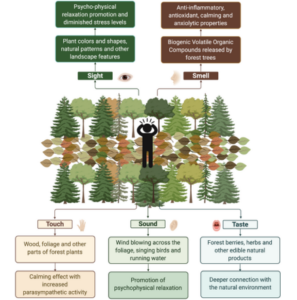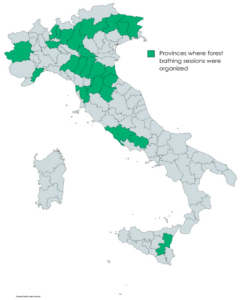Forests for Individual and Public Health – Research body and praxis from Italy
Forest bathing session in "Fonte del Borbotto", Florence Province. Photo Archive of Italian Alpine Club
Forest therapy represents the most important “nature-based programme” for health improvement. Since 2019 extensive research has been conducted in Italy to establish scientific criteria and a methodology to develop Forest therapy initiatives across the country.
Our long standing member Italian National Research Council and the Italian Alpin Club were the initiators.
______________________________________________________________________________________________________________
This expert article was drafted by Federica Zabini (Institute of Bioeconomy, National Research Council of Italy – CNR-IBE – Florence) and Francesco Meneguzzo (CNR-IBE and Central Scientific Committee, Italian Alpine Club, Milan).
Global research on the restorative and healing effects of forest environments has expanded in the last decades, with a strong acceleration since the mid-2010s. If progressive urbanisation and consequent nature deprivation appear as the root causes of such an interest, the combination of aging, growing burden of public healthcare expenditures, and increasing concerns for the stability of the global economy have strongly motivated the turning towards natural medicine resources.
Forest immersion to boost human health was a practice in the Far East (i.e. Japan and South Korea). In 1982, the Japanese national Forest Agency introduced a national health programme of forest immersion (Shinrin-yoku) to reduce stress in the workforce. Later, in 2004 a comprehensive research project to investigate the scientific evidence on the healing effects of forest immersion on human health began.
The interest of the international research community gained momentum since 2016 along with Nature Based Interventions. Later and following the COVID-19 pandemic [1] the UN the recognised forest therapy benefits as a tool for green recovery [2].
A growing body of evidence shows the relevance of nature experience and “green care”. Also, exposure to forest settings has been rigorously linked to both psychological and physiological health benefits.
Forest therapy and related mechanisms
Forest therapy, often named also “forest bathing”, represents the most important “nature-based programme” dedicated to health improvement in the strict sense. Forest therapy initiatives are now spreading globally and resulting in a great diversity of activities.
However, to date, with the exception of Japan, South Korea, and more recently China, these local-level initiatives are largely not embedded in institutional frameworks, from the choice of suitable sites to other elements allowing the achievement of desired health outcomes.
What are the conditions and features of a forest therapy trail allowing to achieve statistically significant health outcomes and thus potentially the incorporation into official clinical treatments?
Forest therapy engagements take place via slow walks along forest trails that facilitate multi-sensory, immersive experiences. Beneficial effects of forest therapy derive from the combined stimulation of all senses, induced by specific features of the natural environment.

Sensory components of forest bathing and their effects on individual well-being.
Image from: Antonelli M, Donelli D, Carlone L, Maggini V, Firenzuoli F & Bedeschi E (2022) Effects of forest bathing (shinrin-yoku) on individual well-being: an umbrella review, International Journal of Environmental Health Research, 32:8, 1842-1867, DOI: 10.1080/09603123.2021.1919293
Disentangling the contribution of single stimuli to the observed effects on human health is hard, due to many confounding factors, either environmental or personal, with stimuli often acting synergically.
Several studies showed that the main factors positively affecting the restorative and relaxation effects of the immersion in forest environments are:
- Naturalness: natural, wild, and uncontaminated forests, with large, old trees, overcoming urban and commercial forests;
- Biodiversity: diverse vegetation communities, high species richness and abundance, native species, vegetation density;
- Forestry structures: easily accessible, open and bright environments;
- Presence of water (e.g. waterfalls, streams);
- Distant view of scenic landscapes (e.g., mountains);
- “Environmental coherence“: the absence of disturbing factors (e.g. plantations, artificial sounds, poorly integrated infrastructure)
Evidence-based standard for a European forest therapy service system – an experience from Italy
Among other contributing factors, the inhalation of biogenic volatile organic compounds (BVOCs) emitted by plants and soil into the forest atmosphere, particularly monoterpenes (MTs), have been suggested as one of the determinants of the health benefits of forest immersion experiences.
The identification of suitable sites to build a networked forest therapy service system requires the consideration of the characteristics of forest sites and trails, and to substantiate the ongoing spreading of forest therapy practices by adopting recognized, evidence-based standards, for the acceptance of forest therapy as a part of officially recognized medical treatments.
In Italy, the effort to establish scientific criteria and a methodology to develop Forest therapy initiatives started in 2019, with a joint project between the Italian Alpine Club (CAI) and the National Research Council of Italy (CNR), which expanded since 2021 to the Italian Ministry of Agricultural, Food and Forestry Policies, CREA (Council for agricultural research and analysis of agricultural economics), Italian National Institute of Health (ISS), and few Italian University Departments.

Source: Antonelli, M.; Donelli, D.; Maggini, V.; Gallo, E.; Mascherini, V.; Firenzuoli, F.; Gavazzi, G.; Zabini, F.; Venturelli, E.; Margheritini, G.; et al. Demographic, Psychosocial, and Lifestyle-Related Characteristics of Forest Therapy Participants in Italy: A Multicenter Cross-Sectional Survey. Healthcare 2023, 11, 1627. https://doi.org/10.3390/healthcare11111627
The participants engaged in a forest therapy session guided by psychologists or psychotherapists following a standardized protocol, lasting approximately 2.5 hours. The session involved slow walking of short duration, with pauses of 15 minutes at five different spots. At each stop, individuals were encouraged to focus on one sense (visual, auditory, tactile, olfactory perception). The protocol includes a 20-minute stop for free immersive activity.
A very extensive campaign was arranged between June 2021 and October 2022, at 39 forest sites across Italy, including mountain, hill, and urban park settings, with more than 1300 adults participating to standardized forest therapy experiences [3].
The large database built upon such campaign allowed to achieve important and original results. For the first time, it was shown that the inhalation of plant-emitted MTs, and in particular α-pinene, produced a specific, dose-dependent anxiolytic effect, independent of any other factor. About 30% of the overall reduction in anxiety symptoms achieved after 2.5-hours of forest therapy sessions in environments endowed with above-the-average MTs concentration, were attributable to the exposure to MTs themselves, with a significant dose-dependent size of the anxiolytic effect [4].
Another study, performed in cooperation with the “Pio XII Institute” Altitude Pediatric Asthma Center at Lake Misurina, eastern Italian Alps, found statistically significant associations between the quantity of monoterpenes inhaled by asthmatic adolescents admitted to the rehabilitation camp and the improvement of their respiratory functions, according to several different measures; such an effect was related to the benefits on the patency of the small airways [5].
These results allowed to define the direct therapeutic role offered by the exposure to forest settings with regards to anxiety and asthma symptoms, and to identify the direct dependence of the health effects on the dose of inhaled monoterpenes.
Moreover, the same results allowed to define some objective criteria for identifying Forest Therapy stations capable of providing clinical level services and assign a specific therapeutic value to each forest and nature site, depending on plant species, extension of forest stands, altitude, climate, and conditions on the season and the period of the day.
Forasmuch as the economic value of protected natural areas, assessed based on the improvement of the mental health of visitors, amounts to about 6% of global gross domestic product (GDP) [6,7], and that anxiety imbalances have been associated with a 52 % increased risk of cardiovascular diseases (CVD), independently of any other risk factors [8,9], any effort aimed at increasing the ecosystem functions and services of natural and protected areas towards human mental and physiological health, including conservation and protection of biodiversity, is widely justified based on benefits to both individual health and public healthcare budgets.